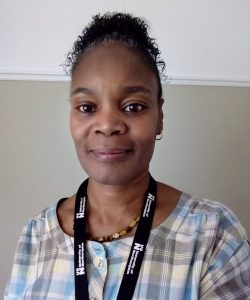Hello everyone,
We are excited about being able to speak to you about our project and sharing some information about ourselves and how the project came into being.
This project came unexpectedly as we were planning a teaching session in May 2021 and here we are now. Before we tell you about the project here is a little about us.
About us
 Patricia: I have worked at the University of Northampton for 5yrs and in the field of nursing for over 20yrs in different areas settling in health visiting and becoming a lead practice teacher, and I am surprised to say nearing another decade. I am passionate about quality, learning, attainment and people reaching their full protentional. During a completed MSc module in influencing change I focused on developing a pathway to support students writing skills, which was born from my experience of supporting referred students. I enjoy meeting with students and supporting them on their journey, yet I tend to shy away from leading and being in the forefront. So, this project will be stretching me, taking me out of my comfort zone and exposing me to new skills, knowledge and interests.
Patricia: I have worked at the University of Northampton for 5yrs and in the field of nursing for over 20yrs in different areas settling in health visiting and becoming a lead practice teacher, and I am surprised to say nearing another decade. I am passionate about quality, learning, attainment and people reaching their full protentional. During a completed MSc module in influencing change I focused on developing a pathway to support students writing skills, which was born from my experience of supporting referred students. I enjoy meeting with students and supporting them on their journey, yet I tend to shy away from leading and being in the forefront. So, this project will be stretching me, taking me out of my comfort zone and exposing me to new skills, knowledge and interests.
 Julia: I am also a nurse by background and have been at the University for around 17 years. During that time, I have been a course member or lead on undergraduate and post graduate health programmes. I also spent several years working on the orientation and adaptation programmes for overseas nurses. My MSc dissertation explored the experiences of IRNs (internationally recruited nurses) coming to work in the UK and I have published some articles in this area. I have been involved in several projects including HEE funded work and collaboratively with other Universities but would describe myself as an enthusiastic fledging researcher. I joined this project after being inspired by Patricia’s passion for improving educational attainment of students from BAME backgrounds; and humbled by the determination to succeed of some of my personal students. This is an area where we believe that we can really make a difference and I am excited to be involved.
Julia: I am also a nurse by background and have been at the University for around 17 years. During that time, I have been a course member or lead on undergraduate and post graduate health programmes. I also spent several years working on the orientation and adaptation programmes for overseas nurses. My MSc dissertation explored the experiences of IRNs (internationally recruited nurses) coming to work in the UK and I have published some articles in this area. I have been involved in several projects including HEE funded work and collaboratively with other Universities but would describe myself as an enthusiastic fledging researcher. I joined this project after being inspired by Patricia’s passion for improving educational attainment of students from BAME backgrounds; and humbled by the determination to succeed of some of my personal students. This is an area where we believe that we can really make a difference and I am excited to be involved.
Why we wanted to do the project?
There has been a change in the demographic trend of the student nursing population, with UON successfully recruiting an increasing number of BAME students to nursing programmes. The black/black British group has seen the largest increase in the past 5yrs with the percentage of black students from adult nursing increasing from approximately 26% to 40%. The student attainment figures however show a persistent gap, this can be seen for example with the percentage of first-class degree’s awarded. In 2015/16 28.6% of black students obtained a first-class degree compared to 40% of white students and in 2019/20 these figures were 24.6% and 47.4% respectively. Despite the increase in diversity, these figures would suggest that strategies are needed to address inequalities and investigate why these disparities occur.
Why personal stories?
Personal stories enhance self-identity and an understanding of the individual’s experiences. This project aims to improve BAME student attainment through addressing unconscious bias and creating inclusive classrooms with the use of personal stories. The use of the collection of authentic individualised stories within teaching and marketing will create opportunities to talk directly about race, racism and the attainment gap. This will facilitate insight into BAME students’ lived experience and the impact of this on attainment and foster a sense of belonging.
Where we are now?
Research shows that experiences within groups differ according to which minority group they are in with disparities within broad ethnic groupings. For this reason, we have decided to focus our work on the Black ethnic minority groups as opposed to BAME in general. This was a change from the original intention. The number of Black students has seen the greatest increase over the last 5 years and so will provide the focus for this work.
We are now in the process of completing the ethics application form and developing the job specification for recruiting 2 students to be co-creators on the project.
